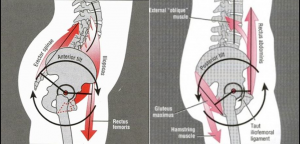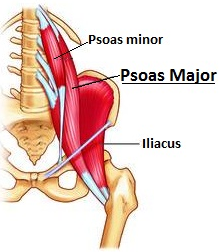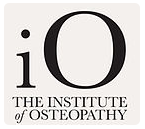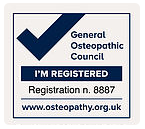Is your back feeling bit worse after the summer? Here’s a possible antidote.
If like many of us this Summer involved long car drives, traffic jams, some cycling and may be some sun lounger action then your hip flexors could now be tighter than normal. These muscles help us bend forwards at the hip. But tighter Hip flexors and in particular Psoas and Iliopsoas can lead to lower back pain.
How?

Tight Psoas causes reduced movement in lumbar spine
If you have been sitting for long periods of time either in the car, on your bike or with your feet up on a sun lounger (lucky you!) or at your desk (not so lucky!) then your hip flexors become tighter.
This would normally cause your body to lean forwards. However your body adapts to ensure you are standing up straight by contracting your postural muscles in your lumbar spine (lower back). This can lead to greater pressure on your lower vertebrae and the associated facet joints as the muscles attached to them tighten up. The extra work load on the postural muscles can lead to strains and spasms. Back pain!
How to help Yourself
The antidote to this is to start a concerted exercise to stretch these hip flexor muscles out from their contracted state. As you can see from the image below the Psoas originates from the lumbar vertebrae in the lower back and connects to inside of the femur (thigh bone).

Psoas helps flex hips
So any exercise must work the muscles fibres that run vertically and those that go at an angle to attach to the femur. This exercise does just that and so is very effective.
The Hip Flexor exercise
The key to this exercise is that it is what’s termed dynamic. It is a movement rather than a static stretch. Research has shown that the body responds better to dynamic movement based exercise designed to increase range of movement than static stretches. It makes sense. Our bodies were designed to move not hold static poses and so our muscles are designed to adapt to movement.
Important points to note
At no point in the exercise is the stretch held as a static stretch
Your hips move forward to dynamically stretch the vertical muscles fibres
Your arm comes up and you bend to the side to dynamically stretch the muscle fibres that attach into your femur.
Do not arch your back in an attempt to gain a greater ‘stretch’ sensation. This can make the muscles in your lower back even tighter and put more pressure on the lumbar vertebrae. Just push forward with your hips.
Repeat the movement 10-15x am and pm daily for best results. Incorporate it into exercise warm up and warm downs too.
It should be a pain free exercise. If you experience pain just stop and contact your Osteopath or other professional physical therapist.
For more information on this exercise and how Hugo can help you return you to your personal best call 0208 226 3767.


